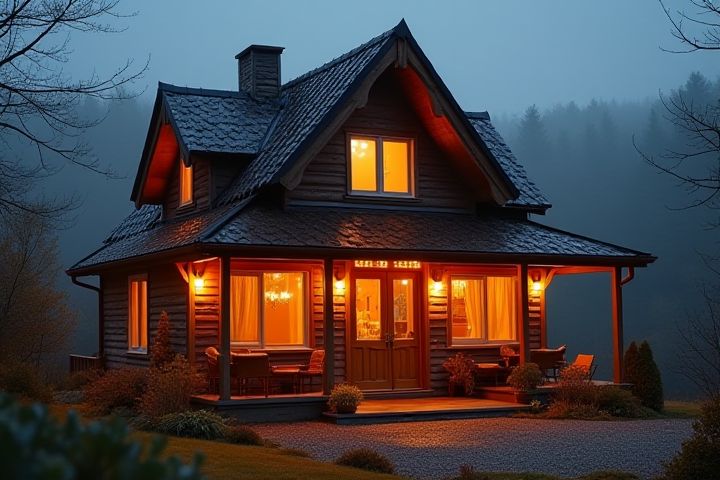
A house typically loses heat through several primary areas, significantly impacting energy efficiency and comfort. Windows and doors often account for substantial heat loss, especially if they lack proper sealing or insulation, allowing cold air to seep in. The roof and attic can also be problematic when insulation is inadequate, leading to heat escape into the outside environment. Walls, particularly those without sufficient insulation or with cracks, can facilitate thermal transfer, diminishing indoor warmth. Finally, the floors, especially in contact with unconditioned spaces like basements or crawl spaces, can contribute to heat loss if not properly insulated.
Where Does A House Lose Heat
Windows and doors
Heat loss in a house often occurs significantly through windows and doors, accounting for around 25-30% of total energy loss. Single-pane windows can lose as much as 15 times more heat than double-pane alternatives, making efficient glazing crucial. Drafts around poorly sealed doors can raise your heating costs by 10-20%, especially if they're not fitted with weather stripping or sweeps. Insulating your windows with thermal curtains or upgrading to high-efficiency models can enhance overall energy performance and reduce heat loss effectively.
Attic and roof
A house frequently loses heat through the attic and roof due to inadequate insulation, which can account for approximately 30% of heat loss. When warm air rises, it escapes through unsealed gaps, cracks, or poorly insulated areas, leading to increased energy bills in colder months. Roofs that lack proper ventilation may trap heat alongside moisture, causing further damage over time. To mitigate this, ensuring at least R-30 insulation in the attic and sealing any leaks can significantly enhance energy efficiency and comfort in your home.
Walls
Walls lose heat primarily through three mechanisms: conduction, convection, and radiation. Insulated walls can help reduce heat loss, but poorly insulated areas, including unsealed cracks and gaps, can account for up to 30% of your home's overall heat loss. The materials used, such as wood, brick, or concrete, also affect the thermal performance, with insulated panels offering better resistance than single-layer walls. In colder climates, the thermal bridging effect, where heat escapes through structural components, can significantly increase energy costs, making it crucial to assess wall insulation thoroughly.
Floors and basements
Floors and basements are significant areas where a house can lose heat, often due to inadequate insulation or air leaks. Heat loss through floors typically occurs when uninsulated or poorly insulated basements allow cold air to rise, resulting in a temperature drop in the living spaces above. In fact, up to 25% of a home's heat can escape through the floors if they are not properly insulated. To mitigate this, consider insulating your basement walls and sealing gaps around doors and windows to create a more energy-efficient environment.
Chimneys and fireplaces
Chimneys and fireplaces account for a significant loss of heat in homes, often up to 14% of total heat loss. When a fireplace is not in use, warm air can escape through the chimney flue, creating an energy drain. Poorly sealed chimney and fireplace systems can exacerbate this issue, allowing cold air to enter and warm air to exit. Using a chimney balloon or damper when the fireplace isn't in use can help mitigate heat loss, ensuring your living space remains efficiently heated.
Ductwork
Ductwork is a critical area where a house commonly loses heat, contributing to energy inefficiency. Leaky duct joints can allow up to 30% of heated air to escape before it even reaches the living spaces. Insufficiently insulated ducts, especially those located in unconditioned spaces like attics or basements, can also result in significant heat loss during colder months. Proper sealing and insulation of your ductwork are essential to maintain optimal heating efficiency and reduce your energy bills.
Electrical outlets and switches
Electrical outlets and switches are common areas where a house can lose heat, as they often create thermal bridges. Gaps or cracks around these fixtures can allow warm air to escape, resulting in energy loss. Installing outlet and switch cover plates with insulating gaskets can significantly reduce this heat loss, improving energy efficiency. Sealing these points can save homeowners up to 20% on heating costs over time.
Plumbing penetrations
A house commonly loses heat through plumbing penetrations, which are openings where pipes pass through walls, floors, and ceilings. These gaps can create thermal bridges, allowing warm air to escape and cold air to enter, contributing to energy inefficiency. Sealing these penetrations with materials like spray foam insulation or caulk can reduce heat loss significantly, often improving your HVAC system's efficiency by up to 20%. Inspect these areas regularly to maintain optimal insulation and energy performance throughout your home.
Poorly insulated areas
A house often loses heat through poorly insulated areas such as attics, which can account for 25% of heat loss, and walls, where approximately 35% of heat exits. Windows and doors, particularly those that are single-pane or have inadequate weather stripping, can contribute to a staggering 10-15% of energy loss. Basements and crawl spaces, especially if not properly insulated, can lose around 10% of heat, further increasing energy bills. Insulating these critical areas effectively can significantly enhance energy efficiency and maintain a comfortable indoor temperature.
Vents and fans
A house loses heat primarily through poorly insulated vents and fans, where conditioned air escapes or cold air infiltrates. Duct leaks can contribute to a staggering 20% to 30% loss of heat, especially when vents are located in unconditioned spaces like attics or crawl spaces. You may also notice that exhaust fans in kitchens and bathrooms can draw warm air outside, potentially leading to a significant temperature drop if not adequately sealed. Regular maintenance and sealing of vents can help minimize these losses, improving your home's energy efficiency and comfort.
